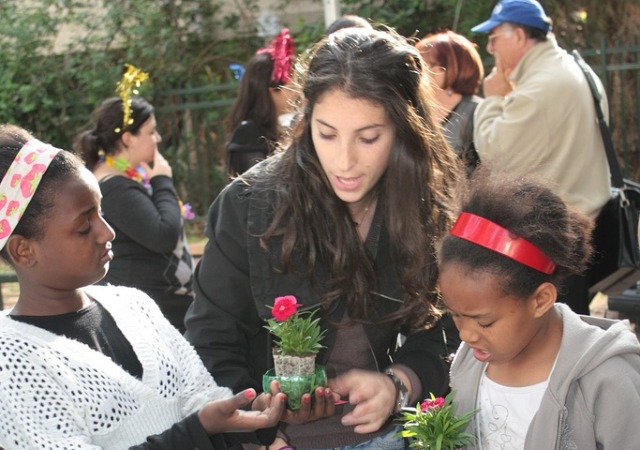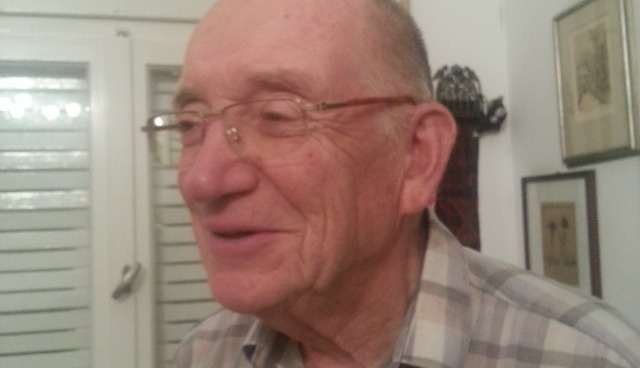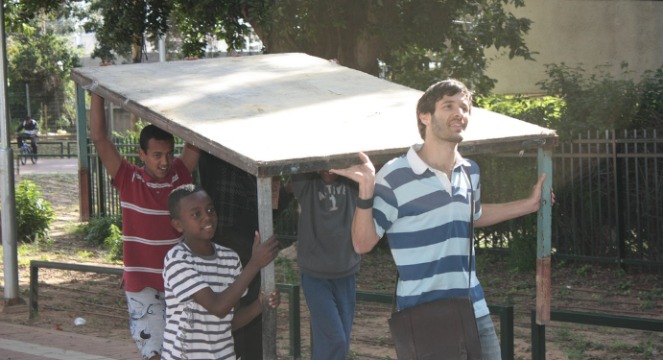Could a proven corporate problem-solving model be used successfully to tackle issues vexing civil society?
The answer is a resounding yes, says former World Bank economist Haim Roet, head of Tze’ela (Citizens Team Action for Social Improvement).
Spread the Word
• Email this article to friends or colleagues
• Share this article on Facebook or Twitter
• Write about and link to this article on your blog
• Local relevancy? Send this article to your local press
Whether it’s schoolchildren concerned about stray animals, university students improving the lives of underprivileged kids, or neighbors seeking a way to help bereaved families, volunteer “social improvement teams” from Tze’ela give ordinary Israelis a systematic, 10-step process to address societal needs.
Roet tells ISRAEL21c that he co-founded Tze’ela in 2009 because he did not see anyone else in the world adapting this proven business approach toward the greater good. He will soon be offering his program to Jewish community centers in the United States and United Kingdom.
“I became acquainted with improvement teams in the business world, and I thought if it works so well in big organizations, why not in the social sector? I found it strange that nobody had done this because it can work anywhere,” says the Dutch Holocaust survivor.
He started Tze’ela along with friends including Prof. Meir Heth, former chairman of the Tel Aviv Stock Exchange and of Teva Pharmaceuticals.
Roet explains that process improvement teams of four to seven members break down every problem into smaller components to be handled separately, using a structured process to bring about a workable conclusion.
Finding solutions systematically
Tze’ela teams include volunteers from Israel’s financial and corporate sectors, who are familiar with this methodology from their careers. The first project was how to identify leadership-building activities for at-risk high school juniors and seniors served by the non-profit educational organization Ma’agalim.

“These teenagers don’t believe in themselves, and we suggested letting them work on a project close to their hearts, something that will improve their environment,” says Roet.
Four years later, Ma’agalim has formed 128 process improvement teams that mentor participants in projects such as refurbishing old synagogues or helping in kindergartens for children with special needs.
“After a few years, we encourage them to use their own mentors,” explains Roet. This way, the partner organizations take ownership of the process.
Chaya Reshef, who heads national projects for Israel’s Association of Community Centers, tells ISRAEL21c that the Tze’ela approach works from the bottom up, transferring responsibility to the grassroots level with the help of mentors from the business world.
She turned to Tze’ela to help solve a longstanding difficulty in one community center about three years ago.
“We couldn’t find a simple solution to solve a sensitive social and educational problem, and we looked for a methodology to help us make progress after years of trying,” Reshef says. “We knew we needed a very systematic process to understand the problem from different angles.”
At first, she was skeptical that a business model could work in the complex social arena. However, she’s come to believe if the teams are chosen carefully and given plenty of leeway to do their work, “there is no problem in the area of my responsibilities that this cannot help. The only ‘problem’ is that the [improvement team] falls in love with the process and it’s difficult to end it.”
Tze’ela mentors are now helping 61 community centers strategize how to build local corporate relationships. Improvement teams are planned for all 170 community centers in Israel.
“With basic guidance from our volunteers, every civil society around the world can implement Tze’ela’s team system to achieve social improvement,” says Roet.
Define problem, collect data
The ISEF Foundation brought in Tze’ela improvement teams to help identify community service opportunities for some of the 500 college and postgraduate students to whom it provides scholarships in exchange for once-weekly community volunteering.

Focusing on the city of Rishon LeZion, they defined a problem – children of poor Ethiopian immigrants coming home from school long before their parents come home from work – and collected data to find a way to improve the situation, Roet relates. Based on the team’s recommendations, ISEF scholars established supervised afterschool activities.
“It worked so well that now the municipality has taken over implementing several of the programs,” says Roet.
Together with Tze’ela, seven ISEF graduate students at the University of Haifa set up an improvement team to raise awareness of the difficulties experienced by people aged 45 and up in entering the workforce. An ISEF group in the south used the approach to design a gently rocking classroom chair that provides a more comfortable sitting posture for kids without disturbing the teacher.
“As we see it,” explains Roet, “society is in itself a very large-scale organization. This organization is faced with numerous complex problems, and citizens who care about their community and surroundings and who wish to help solve some of those problems often do not have the tools or support to contend with such matters.”
The type of problem is irrelevant, he adds. “We are not experts in any particular area, only in management. So we can improve any sort of situation.”
| The 10 Tze’ela steps to social improvement |
| 1. Locate and define a problem to be handled; set up a team; choose a team leader. |
| 2. Determine methods of team communication and coordinate expectations. |
| 3. Collect data and process it to serve as a clear reference during the course of the team’s improvement efforts. |
| 4. Analyze the problem by mapping out various causes. |
| 5. Define the problem in measurable terms that express the current situation, the desired results and the reality that stands between them. |
| 6. Propose possible solutions; evaluate and rank the possibilities; and select the preferred option. |
| 7. Draw up a feasible plan for action to implement the chosen solution; establish a timeline and allocate roles and responsibilities for each team member. |
| 8. Take action! Implement the solution while rallying support and establishing partnerships with stakeholders within or beyond the organization. |
| 9. Substantiate the solutions and determine methods to maintain the results over the long term. |
| 10. Present the team’s work and achievements and set out future points of action. |














